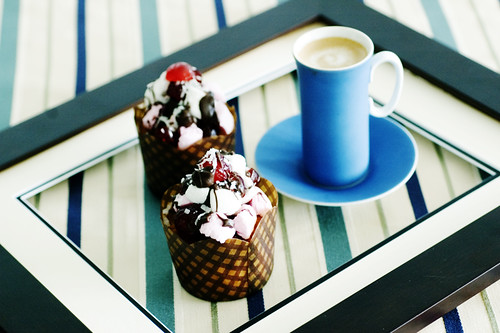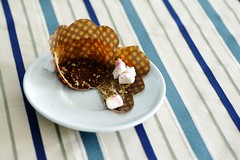The closet geek in me likens commercial cooking to martial arts. Timing in cooking is very intuitive. I once asked my head chef how I should cook meat and he said, “I can’t really tell you exactly. All produce varies in quality, density and size so there are no set guidelines. You just have to feel your way through it.” In other words, use The Force, small fry!
Most professional cooks still evaluate meats by their “feel” and by the way their juices flow:
Bleu meat – cooked at the surface, but just warmed within, remains relatively unchanged – soft to the touch, like the muscle between thumb and forefinger when it’s completely relaxed, with little or no coloured juice (some colourless fat may melt out).
Most junior chefs have a mentor in the kitchen who guides them along. And like many Masters, they would hold something back from their students. Being paranoid myself, my recipes are written to the bare minimum, either enough for myself to understand or it is password protected in my laptop.
Rare meat – some of whose protein has coagulated, is more resilient when poked with the finger – like the thumb-forefinger muscle when the two digits are stretched apart – and red juice begins to appear at the surface. To some people this is meat at its most succulent; to others it is still raw, “bloody” (though the juices are not blood)
Medium-done meat - whose connective-tissue collagen has shrunk, is more firm – like the thumb-forefinger muscle when the two digits are squeezed together – and squeezes droplets of red juice to steak and chop surfaced, while the interior pales to pink. Most but not all microbes are killed in this range.
I made porcini risotto last night for the kitchen and my head chef took his portion home for supper. The next day, he stormed into the kitchen demanding to know who made the risotto. When I bravely confessed, expecting him to crucify me for some form of imperfection, he said, “My girlfriend who hates risotto, actually finished it. Your risotto is fucking awesome”. And trying to respond like a guy in the kitchen, I gave him a nod and said, “Thank you, chef” – I saved the victory dance for when I got home.
Well-done meat – nearly all its proteins denatured, is frankly stiff to the touch, little juice is apparent, and both juice and interior are a dull tan or grey. Microbes are dead, and many meat lovers would say that the meat is too. However, prolonged, gentle cooking will loosen the connective tissue harness and bring back a degree of tenderness.
Sunday, March 30, 2008
Tuesday, March 11, 2008
Rocky Road Cupcake
Also known as food shoot number 2 (a collaboration with highly talented Camera Girl).
I only use pure butter in cakes so even after 3 days, the cake still tastes good (plus, I am a butter snob). The tops are made with maraschino cherries, coconut flakes, pink & white marshmallows and drizzled with melted milk chocolate. Because this was catered for a two-year-old kindergarten party, I opted not to include any nuts and left the bases quite plain. Otherwise, I would have made a triple colour marble cupcake base.
For the rest, the entire shoot was done using natural light and one reflector and a tripod.



The best part is eating it though!

I only use pure butter in cakes so even after 3 days, the cake still tastes good (plus, I am a butter snob). The tops are made with maraschino cherries, coconut flakes, pink & white marshmallows and drizzled with melted milk chocolate. Because this was catered for a two-year-old kindergarten party, I opted not to include any nuts and left the bases quite plain. Otherwise, I would have made a triple colour marble cupcake base.
For the rest, the entire shoot was done using natural light and one reflector and a tripod.



The best part is eating it though!

Monday, March 10, 2008
I have not eaten dog shit, but if I did, it probably tastes like Australian “Malaysian Satay”
I am so grateful for immigration because along with the cheap, hardworking foreign labour (especially dishwashers) it brings into Australia, it also gives us a taste of exotic cuisine. However, as appreciative as I am to be able to eat “beef rendang” at my local, as a Malaysian, I am terribly ashamed of the monstrosity that Australians identify as Malaysian Satay. First of all, satay sauce is made from ground spices, roughly chopped peanuts and coconut milk that has been simmered for hours, not bloody peanut butter and chilly! When I have more clout in the food scene, I aim to start an “Authentic Cuisine” movement and petition against bastardized crap. The Authenticity Label should be just as important as the Heart Foundation Tick. Come on guys, if you have to tailor your food to “suit local tastebuds”, the locals don’t deserve it!
The Dubious Origins of the Chinese Fortune Cookie:
San Francisco and Los Angeles both lay claim to the origin of the fortune cookie. Makoto Hagiwara of Golden Gate Park's Japanese Tea Garden in San Francisco is said to have invented the cookie as an extension to Japanese desserts in 1909 (Martin 2004), while David Jung, founder of the Hong Kong Noodle Company in Los Angeles, is said to have invented them in 1918 (Brunner 2005). San Francisco's mock Court of Historical Review took the case in 1983. A federal judge of the Court of Historical Review determined that the cookie originated with Hagiwara and the court ruled in favor of San Francisco. Subsequently, the city of Los Angeles condemned the decision.
1. Martin, James (2004), "Fortune Cookies: A San Francisco Invention"
2. Brunner, Borgna (2005), "The History of the Fortune Cookie"
I feel sorry for vegetarians/ vegans/ people with allergies in general because they probably get discriminated on a regular basis. I remember when my younger sister would receive the same reaction from people when she told them that she was a vegetarian – they responded as if she had just died. Little do these “special diet people” know that they also cause a cruder response in the commercial kitchen as well. We especially do not respond well to vegans because we rely on pounds of butter.
How to season a new Moroccan Tajine:
1. Soak tajine for at least 24 hours prior to its first use
2. Leave it to dry in the sunlight (preferable the garden) for a few days
3. Rub olive oil in the inner surfaces of the lid and base
4. Put 1 cup of water, some bay leaves, chilly, salt and pepper into the tajine and place in a cold oven. Set the temperature at 200°C and leave for an hour.
5. For its first few uses, do not go over 240°C but gradually work your way towards this high temperature
6. Good tajines can be used over gas stoves (on top of a heat diffuser), ovens and barbeque grills
7. There is a huge difference when using the tajine because of the flavour that it imparts into the food.
The Dubious Origins of the Chinese Fortune Cookie:
San Francisco and Los Angeles both lay claim to the origin of the fortune cookie. Makoto Hagiwara of Golden Gate Park's Japanese Tea Garden in San Francisco is said to have invented the cookie as an extension to Japanese desserts in 1909 (Martin 2004), while David Jung, founder of the Hong Kong Noodle Company in Los Angeles, is said to have invented them in 1918 (Brunner 2005). San Francisco's mock Court of Historical Review took the case in 1983. A federal judge of the Court of Historical Review determined that the cookie originated with Hagiwara and the court ruled in favor of San Francisco. Subsequently, the city of Los Angeles condemned the decision.
1. Martin, James (2004), "Fortune Cookies: A San Francisco Invention"
2. Brunner, Borgna (2005), "The History of the Fortune Cookie"
I feel sorry for vegetarians/ vegans/ people with allergies in general because they probably get discriminated on a regular basis. I remember when my younger sister would receive the same reaction from people when she told them that she was a vegetarian – they responded as if she had just died. Little do these “special diet people” know that they also cause a cruder response in the commercial kitchen as well. We especially do not respond well to vegans because we rely on pounds of butter.
How to season a new Moroccan Tajine:
1. Soak tajine for at least 24 hours prior to its first use
2. Leave it to dry in the sunlight (preferable the garden) for a few days
3. Rub olive oil in the inner surfaces of the lid and base
4. Put 1 cup of water, some bay leaves, chilly, salt and pepper into the tajine and place in a cold oven. Set the temperature at 200°C and leave for an hour.
5. For its first few uses, do not go over 240°C but gradually work your way towards this high temperature
6. Good tajines can be used over gas stoves (on top of a heat diffuser), ovens and barbeque grills
7. There is a huge difference when using the tajine because of the flavour that it imparts into the food.
Thursday, March 6, 2008
The only time you can call me a bitch is when you put “Grill” before it

I was in the CD store and chatting with the owner who could not believe that I was a chef until he saw the scars on my arms. I have now reconciled with myself that as long as I am a chef, I will never have nice nails or hands. Perhaps this is also a suggestion to hand cream manufacturers to use chefs as their ultimate litmus test, rather than using animals.
Tips on Char-Grilling Steaks:
Always oil the meat before cooking, to maintain its moisture.
Let the meat rest to allow the muscles to relax so that the juices are retained within the meat. As long as you do not cut it, it will retain its heat for a few minutes.
Have you ever eaten out and appreciated the perfection of your ordered meal? How the meat is cooked just the way you asked; how the vegetables and mash are also nice and hot? And how everyone gets his or her food at the same time? Commercial cooking is almost like a well-coordinated orchestra. Usually the sous chef conducts the entire operation. The order comes in for seared salmon with Asian vegetables, medium rare grilled eye fillet and a side of truffled mash. The sous chef starts searing the meat and as the meat is three minutes away from ready, calls out for the mash to be heated. Two minutes away - the vegetables are dropped in the boiling water and the chef calls out for the fish to be cooked. One minute away – the meat and fish are left to rest, while everything else is assembled on the plates by the sous chef. Now imagine trying to handle orders from ten tables with about six persons per table.
Total grilling times for a 450g rump, sirloin, entrecote, porterhouse or T-bone beef steak
Rare: 6-8 minutes
Medium: 10-12 minutes
Well done: 12-14 minutes
Total time will vary depending on the type of pan, heat, quality an thickness of the meat.
Within 3 days of stepping into the industry, I was promoted to Breakfast Chef and now after approximately 3 weeks, I have taken the responsibilities of the Sous Chef (although I am not allowed to formally have the title because I’m not a qualified chef). I can finally call myself The Grill Bitch and have apprentices cook my meals. The power trip becomes me.
Sunday, March 2, 2008
I'd like something that sounds awfully expensive & exotic, please.
I am not sure what irks me more – chefs mispronouncing French cooking terms or chefs misusing them. This must be the product of informal education between apprentices and chefs that go unchecked. In combination with deep-seeded insecurities of lacking in university qualifications, they abuse French terms to sound intimidating and smart. I now tolerate a younger (and overly confident) chef who keeps using the term “mise en place” for service and I cringe every time he does so.
Mise en place: French literal term “put in place”, meaning that the preparation is ready up to the point of cooking.
In combination of the actual taste of the dish and its presentation, one other factor is rarely given credit – the vivid illustration written in the menu. Beautiful prose often serves as the mental appetiser to what is to come. Beef steak, gravy with a vegetable stack gives the impression that one is eating at an Retired Services League club, but if it was described as Grain Fed Angus eye fillet, served with a red wine jus and a tien of summer vegetables, one would more likely associate it with fine dining. Make it sound exotic and intimidating – if it works in the kitchen, it would certainly work in the restaurant!
Grain-fed: Fed grain-dominated rations for a minimum of 3 months in controlled conditions, Such beef has maximum marbling,
Grass-fed: Raised and fattened on pasture. Advocates of grain-fed beef suggest that climatic variations and seasonal differences can lead to an inconsistency of quality in grass-fed beef.
Mise en place: French literal term “put in place”, meaning that the preparation is ready up to the point of cooking.
In combination of the actual taste of the dish and its presentation, one other factor is rarely given credit – the vivid illustration written in the menu. Beautiful prose often serves as the mental appetiser to what is to come. Beef steak, gravy with a vegetable stack gives the impression that one is eating at an Retired Services League club, but if it was described as Grain Fed Angus eye fillet, served with a red wine jus and a tien of summer vegetables, one would more likely associate it with fine dining. Make it sound exotic and intimidating – if it works in the kitchen, it would certainly work in the restaurant!
Grain-fed: Fed grain-dominated rations for a minimum of 3 months in controlled conditions, Such beef has maximum marbling,
Grass-fed: Raised and fattened on pasture. Advocates of grain-fed beef suggest that climatic variations and seasonal differences can lead to an inconsistency of quality in grass-fed beef.
Subscribe to:
Posts (Atom)
